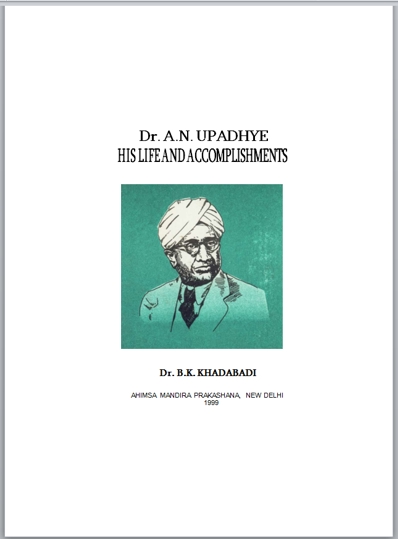This miracle occurred in 1939 and after that he continuously and sincerely worked in his field right up to 1975 and immensely enriched it. Let us see this now:
The Field Of Research, Writing And Editing Ancient Works
Dr. Upadhye has turned out most of such work while he was serving as Professor in the Rajaram College.
After finishing teaching, guiding etc. in the college, coming home, attending to research, writing and editing was his regular and compulsory part of life. For him it was rather an intellectual hobby. He utilised every day of his leisure time (morning and evening) and also the Dipavali and Summer Vacations for this work.
He was completely absorbed in such work in his study-room. Besides mostly working alone, many times while doing editorial work of ancient Prakrit and Sanskrit works, particularly while deciding texts of manuscripts, he had by his side a Shastri with whom he discussed and wrote down various notes concerning the decided texts. He sat with a pile of books with paper-slips inserted between their certain leaves on one side, and a heap of opened files kept one upon another on the other side and drowned, with a pen and paper slips, in his study and research. The work strenuously turned out by him in this manner is vast, varied and of very high standard. It was appreciated in glowing terms by several eminent scholars in India and abroad through personal letters and in reviews published in national and international research journals. The medium of almost all such work done by him is English and its magnitude, variety and quality would surprise anybody.
- The number of his critically edited books is about 30. They possess learned and detailed introduction, honest settling of texts, required notes and explanations, appendices, indices, bibliography etc.
- Research papers written on different subject and published in renowned journals, felicitation volumes, commemoration volumes etc. are about 185, of which 18 are in Kannada.
- Reviews of books written by eminent scholars in India and abroad are about 76.
- Forewords written to books of other scholars are about 14, of which 2 are in Kannada.
- Books brought out under his general editorship, sometimes in collaboration with some other scholars, are about 80, of which 15 are in Kannada. Among these, 50 books have come out under publications of the Bharatiya Jnanapitha, Delhi, 30 have come out under Jivaraj Granthamala, Solapur, and under Prakrit Text Society, Ahmedabad and other such institutes.
It is worth noting that several critically edited Prakrit and Sanskrit works throw fresh light for the first time. Scholarly and detailed introduction, with discussion on authorship, date, style etc., honestly decided text-material, explanatory notes on significant points etc. are the special features of his ripe and unique research and editorial style. We can learn about these from eminent scholars and critics alone.
Dr. V.S. Agarwal (Hindu University, Benares writes: "Dr. Upadhye is a past-master in the art of critical editing. He combines in himself the learning of the Oriental Pandit and the argue-eyed critical faculty of new scholar, with which he approaches his task." Regarding his Brhatkathakosa, Dr. Sunitikumar Chatterjee (Calcutta University) opines in a letter written to Dr. Upadhye himself: "It is really a magnum-opus for which any scholar may feel proud. The learned introduction is a model of what an introduction should be. Your extensive learning and your prodigious industry both elicit unstinted admiration."
Prof. Renou (Paris University) writes about his Lilavaikaha in the Journal of the Bhandarkar Oriental Research Institute, Poona: "It is superfluous to recall that the entire work is executed by a master hand. After so many other publications, which succeed one another in a rapid rhythm, the edition of Lilavaikaha firmly established the name of Dr. Upadhye in the front rank of the present day Jaina and Prakrit scholars in India."
Prof. Ludwig Alsdorf, Hamburg University writes in a letter to Dr. Upadhye about his Tiloyapannatti, "... splendid performance of your unique edition of the Tiloyapannatti... There seems no doubt that it is a very important work of considerable antiquary. I fully realize how arduous your tasks have been and what stupendous amount of hard work is incorporated in the preparation of this volume."
Thus these gems of Dr. Upadhye's numerous works, as appreciated by many Indian and foreign scholars, earned name for him from all parts of the world. As a result of this many awards, degrees, honours etc. followed him. If one work got for him D.Litt degree, the other got state award, another got national award, the collective consideration won Presidents's award. Presidentships of All India Conferences and Seminars, felicitations and honours from the various institutions were not a few. Yet till the end of his life Dr. Upadhye lived a gentle, humble, unassuming, sincere and loyal scholar's life.
 Dr. B.K. Khadabadi
Dr. B.K. Khadabadi
